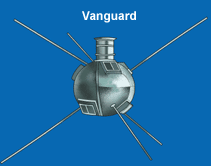
Dimdima
Online Children's Magazine from India

Dimdima
Online Children's Magazine from India
First Success for the US

The United States, desperate to catch up with the Soviet Union in the field of space exploration, notched its first success with the launch of the satellite, Explorer 1, from Cape Canaveral on 31 January 1958.
Explorer 1 weighed just 14 kilograms. It made one orbit every 114 minutes, coming as close as 356 kilometres and moving away as far as 2550 kilometres from Earth, during its journeys around it. The information it sent back led to the discovery of the Van Allen radiation belts around our planet.
America’s first satellite stopped transmitting after 4 months but continued to orbit Earth for more than 12 years, finally re-entering the atmosphere on 31March, 1970.
Vanguard 1, the second US satellite was launched on March 17, 1958. While Explorer was cylindrical, Vanguard 1 was a grapefruit-shaped sphere. It orbited Earth between 650 and 4000 kilometres. Analysis of its orbit revealed that our planet is not quite round, but pear-shaped – elevated at the North Pole and flattened at the South Pole.
Vanguard’s battery-operated transmitter stopped operating in June 1958 when the batteries ran down. The solar-powered transmitter operated until May 1964.
Vanguard 1 continues to orbit Earth. It is the oldest satellite still in orbit at this time. It is expected to continue circling Earth for another 200 years or so till external forces slow it down and cause it to fall back to Earth.
 The US launched three satellites in the Vanguard series. Initially managed by the Naval Research Laboratory, the programme was transferred to the National Aeronautics and Space Administration (NASA) when it was created in mid-1958.
The US launched three satellites in the Vanguard series. Initially managed by the Naval Research Laboratory, the programme was transferred to the National Aeronautics and Space Administration (NASA) when it was created in mid-1958.
EXPLORE MORE...
Get Help or Give Help.
- Do you have a Science Question?
- Post it here and get the answer.
- Some questions posted by others are not yet answered.
- View those questions and answer them.
Dimdima is the Sanskrit word for ‘drumbeat’. In olden days, victory in battle was heralded by the beat of drums or any important news to be conveyed to the people used to be accompanied with drumbeats.
Bharatiya Vidya Bhavan
K. M Munshi Marg,
Chowpatty, Mumbai - 400 007
email : editor@dimdima.com
Bharatiya Vidya Bhavan
505, Sane Guruji Marg,
Tardeo, Mumbai - 400 034
email : promo@dimdima.com
Dimdima.com, the Children's Website of Bharatiya Vidya Bhavan launched in 2000 and came out with a Printed version of Dimdima Magazine in 2004. At present the Printed Version have more than 35,000 subscribers from India and Abroad.